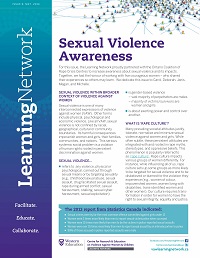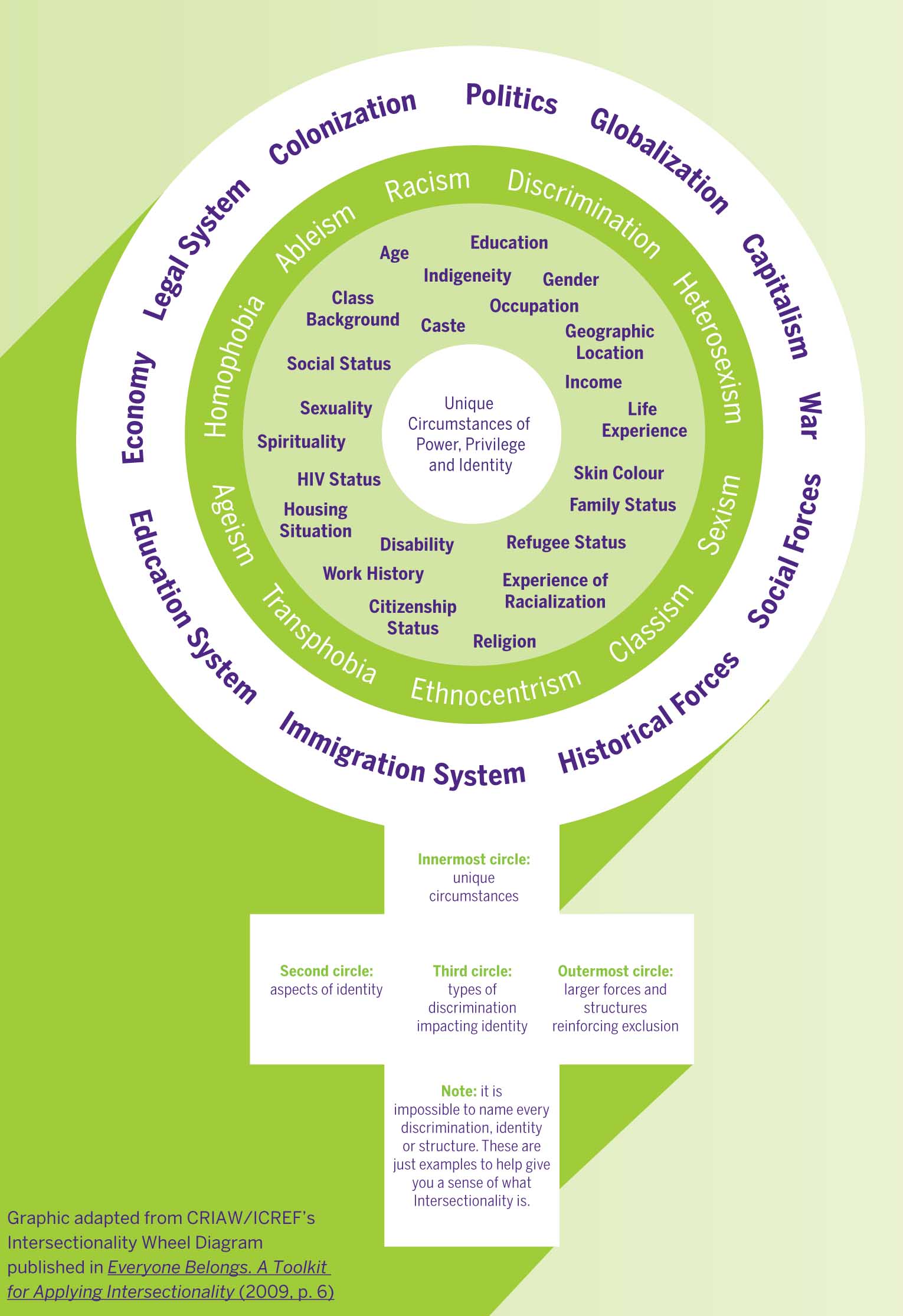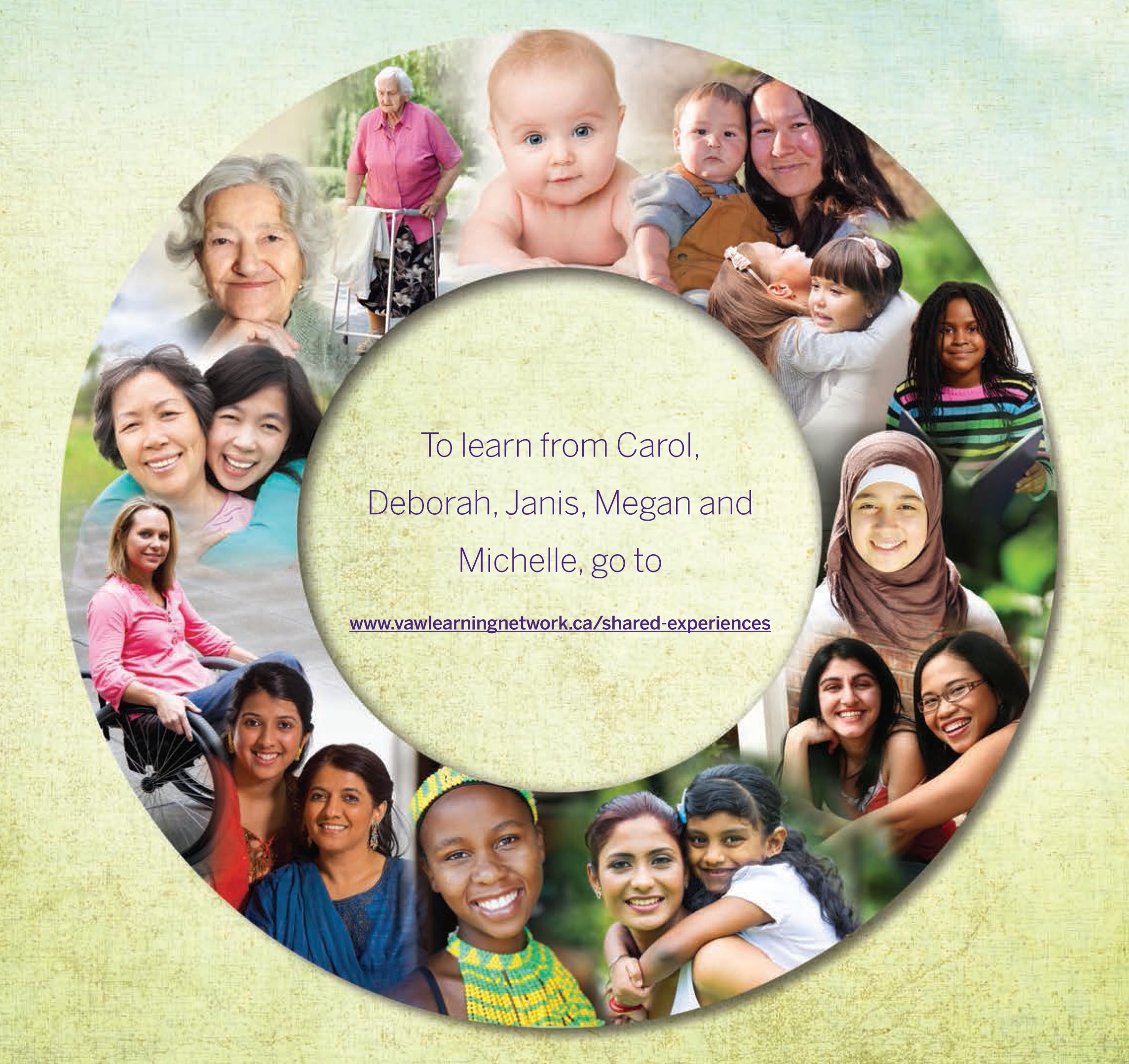Issue 9: Sexual Violence Awareness
 Printable PDF version
Printable PDF version
PlainText Newsletter
For this issue, the Learning Network proudly partnered with the Ontario Coalition of Rape Crisis Centres to increase awareness about sexual violence and its impacts. Together, we had the honour of working with five courageous women – who shared their experiences so others may learn. We dedicate this issue to Carol, Deborah, Janis, Megan, and Michelle.
Sexual Violence Within Broader Context of Violence Against Women
Sexual violence is one of many interconnected expressions of violence against women (VAW). Other forms include physical, psychological and economic violence. Like all VAW, sexual violence is not confined by racial, geographical, cultural or community boundaries. Its harmful consequences impoverish women and girls, their families, communities, and nations. This serious systemic social problem is a violation of human rights rooted in persistent discrimination against women.
Sexual Violence…
- refers to any violence, physical or psychological, carried out through sexual means or by targeting sexuality (e.g., childhood sexual abuse, sexual assault, drug facilitated sexual assault, rape during armed conflict, sexual harassment, stalking, sexual cyber harassment, sexual exploitation)
- is gender-based violence
– vast majority of perpetrators are males
– majority of victims/survivors are women and girls - is about exerting power and control over another.
What is 'Rape Culture’?
Many prevailing societal attitudes justify, tolerate, normalize and minimize sexual violence against women and girls. While often subtle, these persistent attitudes are integrated with and rooted in rape myths, stereotypes, and oppressive beliefs. This phenomenon is popularly referred to as ‘rape culture’. Rape culture impacts various groups of women differently. For instance, while influencing all of us, rape culture sets up some groups as more likely to be targeted for sexual violence and to be disbelieved or blamed for the violation they experience (e.g., women of colour, impoverished women, women living with disabilities, trans-identified women and other women). Our culture requires transformation in order for women to have the right to sexual integrity, equality and justice.
The 2013 report from Statistics Canada indicated:
- Sexual crimes were by far the most common offence committed against girls under 12
- Women were 2 times more likely than men to report sexual victimization when surveyed
- Women were 11 times more likely than men to be the victims in police-reported sexual assaults
- Women were over 35 times more likely than men to report sexual assault by an intimate partner to police
- 99% of those accused in police-reported assaults were male
Intersectionality: An Essential Lens for Reading the Statistics
Statistics raise awareness about the incidence and prevalence of VAW in general and in various socially-located communities. For example, we know that women from different communities experience different barriers to accessing support; when disclosing their experiences of sexual violence; or when interacting with the criminal justice, health or social services systems. However, group statistics do not always convey the experiences of women who may belong to more than one community – for example, a woman who is an immigrant as well as a youth; or a queer-identified woman who lives in a rural setting – and the differences within the communities themselves. This intersectionality diagram is presented with the following statistics to encourage us to think about differences and the multiple, layered forces that interact to reinforce conditions of inequality and social exclusion – that is, the roots of violence.
- Women in the NWT and Nunavut are at 9-12X greater riskof experiencing sexual violence than women in other provinces.
- 6 out of 10 Deaf female students in the U.S. experienced at least 1 form of sexual coercion in an intimate relationship.
- Almost 1 in 4 sexual assault victims reporting to medical treatment centres in Ontario were suspected to have been drugged.
- 1 in 5 women living on the street in Toronto were sexually assaulted in the past year.
- About 80% of sexual assaults against older women in Canada (55-87yrs.) occurred in their homes.
- About 1 in 4 sexual assaults against younger women in Canada occurred in a vehicle.
- In 86% of the 3,337 completed investigations of sexual assault in 2013 in the U.S. military, the victim was female. In about 90% of these assaults, the perpetrator was male.
- 1 in 5 LBG individuals in Canada experienced physical/sexual violence in an intimate relationship, with bisexual women reporting this type of violence most often followed by gay men, lesbian women, and bisexual males.

Learning from Women with Lived Experience
Sexual violence can be experienced at any age and the impacts a woman experiences differ at various stages of her life and healing journey. Survivors share that many contexts – not just the physical details of the violent act itself – shape the impacts of sexual violence through life, and a victim’s attempts to reach support e.g., relationships to perpetrator, response to disclosure, social location).
Listening to women with lived experience, we learn about the ways women are impacted by and how they cope with sexual violation – that is, what supports, activities or comforts helped them to survive the most challenging parts of their experience. For these reasons, we collaborated with Carol, Deborah, Janis, Megan, and Michelle, who in sharing their experiences of sexual violence, illuminate how individual women are impacted differently – including their experiences with systems meant to support victims/survivors.

What is Drug Facilitated Sexual Assault (DFSA)?
DFSA occurs when alcohol or other drugs are used to sedate or incapacitate a person in order to perpetrate sexual assault.
Types of DFSA include:
Proactive |
a perpetrator puts a drug into a victim’s drink or gives a victim alcohol until she becomes inebriated and incapacitated |
Opportunistic |
a perpetrator targets a person who is already intoxicated or incapacitated |
1 in 5 victims/survivors reporting sexual assault to a sexual assault treatment centre were found to have experienced drug facilitated sexual assault.
Surfacing the Social Context of Sexual Violence in Therapeutic Settings
“What shall I use as a diagnosis when I bill for this [therapy] session?... ‘oppression, gender-based’…?” – Marcia Hill1
As Hillary Clinton pointed out in 1995, “it is a violation of human rights when individual women are raped in their own communities”2. But how do we talk about this – that is, sexual violence, as a systemic social problem – with survivors in a therapeutic setting?
Eight Strategies for Counsellors
- Clearly name sexual violence as violence.
- Identify victim-blaming myths and rhetoric in media stories of sexual violence, or other public discussion of sexual violence.
- Discuss victim-blaming myths and rhetoric in counselling sessions.
Learn about all 8 strategies
References
1 Hill, Marcia. 2004. Diary of A Country Therapist. The Haworth Press Inc. NY: 81
2 Clinton, Hillary Rodham. Remarks For The United Nations Fourth World Conference On Women. Beijing, China. September 5, 1995. Online: http://www.un.org/esa/gopher-data/conf/fwcw/conf/gov/950905175653.txt
Check out our infographic on consent
Check out the Resources developed by the Learning Network on Sexual Violence
Pietsch, Nicole (May 2014). Learning from Women with Lived Experience. Learning Network Brief (22)
Eight Strategies for Doing the Work: Surfacing the Social Context of Sexual Violence in Therapeutic Settings. Learning Network Tool 3





